Healthy Aging: Consumers embrace the passaging of time and look towards wellness
Anti-aging is becoming an outmoded concept when strictly applied to cosmetics. The consumers’ mindset is shifting to now accept aging as a part of life. Instead of fighting against aging by using products with traditional anti-aging claims, they are instead embracing their years and look for cosmetic solutions to support wellness. With increasing knowledge of the factors that contribute to aging, savvy consumers are looking for a means to prevent skin damage to mitigate the accelerated aging process. This change in thinking coincides with the emerging quest for well-being that has been taking hold in recent years.
Perhaps the most visible example of this trend is seen with the gray hair revolution, with women in their 20s and 30s embracing their gray hair instead of trying to cover it up. In fact, there is an Instagram account devoted entirely to going gray naturally with nearly 120,000 followers and 1,200 posts of women sharing pictures of their graying hair. Further, fashion and trade magazines are now using terms such as “well-aging”, “pro-aging” and “slow-aging” instead of anti-aging for their communications on the topic. Last September, Allure magazine was the first to openly state they “will no longer use the term ‘anti-aging’”.
Recent skin care innovations to promote healthy aging
The cosmetic industry is perpetually looking for new solutions to help consumers feel good about themselves and their bodies despite the passing of time. These efforts are supported by the industry’s evolving knowledge of skin biology. We now know there are three main causes of aging: chrono-aging which is due to the passage of time, photo-aging, which is the result of UV exposure and inflammaging which is caused by chronic inflammation. Although inevitable, some of the processes related to chrono-aging can be slowed. On the other hand, inflammaging and photoaging both accelerate aging at a faster pace, yet they are more easily controlled. These two forms of aging, are the primary focus of novel well-aging ingredients.
For example, a research team recently published their work on the biological mechanism that regulates the cell’s circadian rhythm through the expression of four main gene biomarkers, Per, Clock, Bmal and Cry. The researchers earned the Nobel Prize in Physiology and Medicine in 2017. They showed that all cells, including skin cells, have a circadian rhythm. The circadian rhythm activates defense mechanisms against aggressors during the day and activates recovery mechanisms at night which allow for efficient biological function. This research has inspired the development of active ingredients that help stressed and dysregulated skin to recover a normal circadian pattern. As a result, cells can more efficiently fight the inflammatory processes triggered by toxins or irritants to allow for better recovery from daily aggressors including UV exposure. This ultimately helps control processes related to both inflammaging and photo-aging. By setting the clocks of the skin cells back on time, skin recovers its well-being to age well.
Other environmental factors are also of concern. With air pollution on the rise and quickly being recognized as one of the largest environmental risks contributing to our health and aging, there is a need to protect the skin from pollutant-related stress. It is understood that environmental pollutants including particulate matter, PAHs and heavy metals increase inflammatory reactions that further stress the skin and disrupt its healthy barrier. Anti-pollution protection can be achieved through two ways, either by directly preventing pollutant microparticles from adhering to the skin or by enhancing the removal of these microparticles. Preventing microparticle adherence inhibits subsequent inflammatory reactions from occurring while enhancing rinse-off and the natural detoxification pathway limits chronic inflammatory reactions that impair structure and contribute to inflammaging.
Intrinsic mechanisms to support healthy chrono-aging is another growing area of focus. Since the Human Genome Project was completed in 2003, we know that only 1.2% of the genome encodes for protein, the rest is transcribed into non-coding RNA (ncRNA). These ncRNAs are classified according to size with the most common being small sized RNAs (20 to 30 nucleotides in length) which include ribosomal RNAs (rRNAs), transfer RNAs (tRNAs, small RNAs (sRNAs) and micro RNAs (miRNA). Transcripts longer than 100 nucleotides are referred to as long non-coding RNAs (lncRNAs). Although their mechanisms of action are for the most part still poorly understood, some have been shown to affect biological function and induce premature aging in various diseases and organs. As a result, they are a high area of focus for the pharmaceutical industry. Just like small ncRNAs, the long ncRNAs can regulate gene expression to prevent the transcription and translation of genes into proteins. Additionally, their larger size allows them to structurally interact directly with proteins and can impact protein activity. Research on long ncRNAs with organs other than the skin has identified them as an important target for the cosmetic industry as they show strong potential for slowing the pace of chrono-aging.
Active ingredients for well-aging
Natural, active ingredient manufacturers are developing extracts with proven performance against the three primary causes of aging to help consumers in their quest for healthy aging. Clariant Active Ingredients conducted multiple research efforts to uncover active ingredients from natural origins that target the areas of chrono-, photo- and inflammaging either separately or combined.
After extensive research on long non-coding RNA nc886, Clariant Active Ingredients demonstrates a link between aging and a decrease in the level of nc886 expression in skin. This long non-coding RNA is known to deactivate Protein Kinase R (PKR), a protein that induces premature aging in diseases and organs. PKR also activates the maturation of Caspase 1, an enzyme that plays a central role in initiating the inflammatory response. Additionally, UVB exposure is shown to strongly inhibit the expression of nc886 which leads to increases in the production of MMP-9, a metalloproteinase that degrades collagen IV. Collagen IV is one of the primary components of the dermal-epidermal junction and is essential for ensuring good communication between the two layers. Decreases in collagen IV expression impair skin structure to accelerate cellular aging. Epseama, a brown seaweed extract derived from Laminaria japonica was selected after screening 200 extracts for nc886 performance. It increased nc886 expression better than any other extract tested and can simultaneously address chrono-aging, inflammaging and photo-aging. Further it can help strengthen skin by boosting collagen and laminin 5 production.
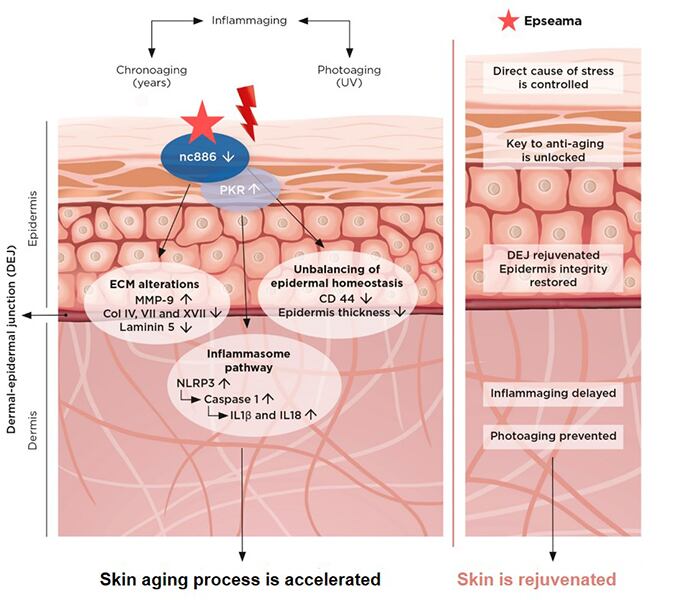
To efficiently protect skin from inflammaging triggered by pollutants, Eosidin, an extract derived from Citrus unshiu is shown to support healthy immune function. Chronically exposed skin heightens the immune response to allergens and pollutants. This triggers a vicious cycle leading to chronic irritation and itching that further compromises skin barrier function. Eosidin supports proper immuno-modulation by decreasing eotaxin-1 synthesis and inhibits the JAK/STAT pathway to efficiently limit inflammatory phenomena and prevent inflammaging.
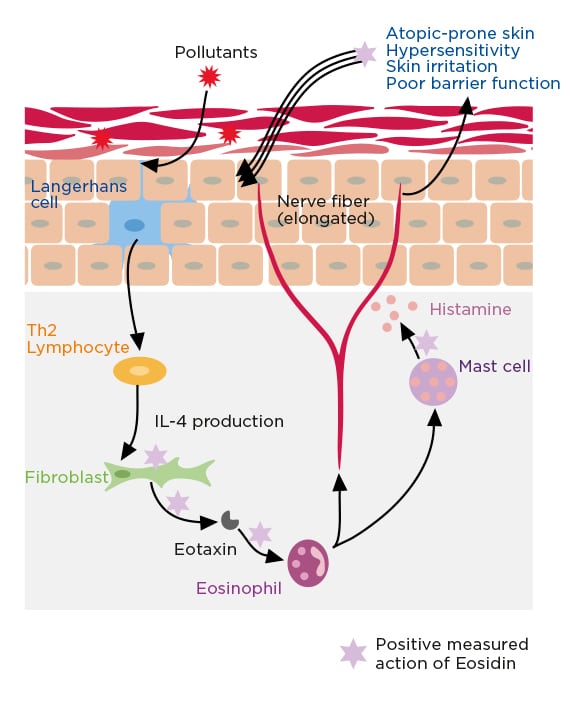
Further, to protect skin from premature pollutant-related aging, RedSnow, an extract from Camelia japonica is shown to block the xenobiotic response initiated by pollutants thus reducing inflammatory reactions. This allows RedSnow to mitigate the inflammaging processes. It also increases collagen I synthesis to restore the dermal extracellular matrix and increase dermal density.
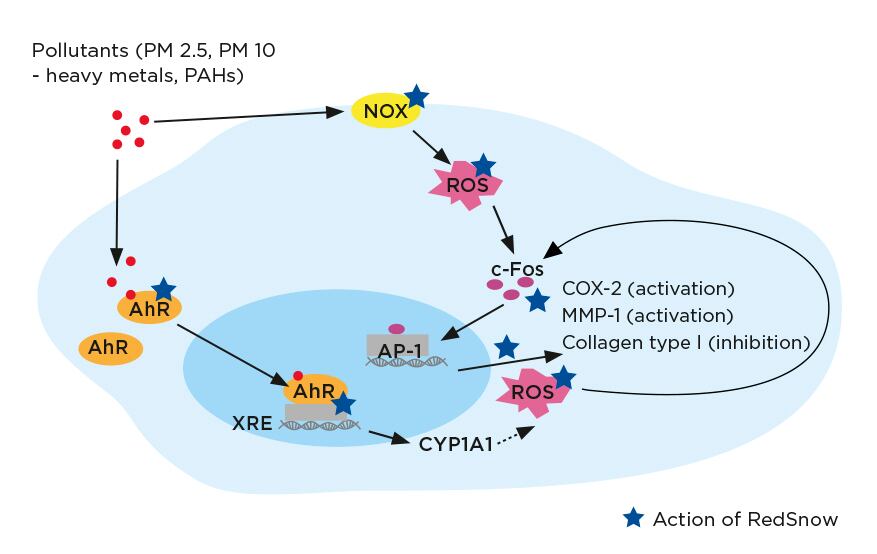
With time pollutants and toxins accumulate in skin, this can overwhelm and decrease the efficiency of the skin’s innate detoxification pathway. BioDTox, an extract derived from three plants recognized as a source of three bio-active molecules, bioflavonoids (from citrus), polyphenols (from aloe) and sulforaphane (from broccoli) can boost the detoxification process and improve efficiency. It increases the expression of key enzymes in phase II of the detoxification pathway, specifically heme oxygenase I, NADH and thioredoxin reductase I. These detoxifying biomarkers also inhibit the formation of free radicals that accelerate chronoaging or lead to inflammaging.
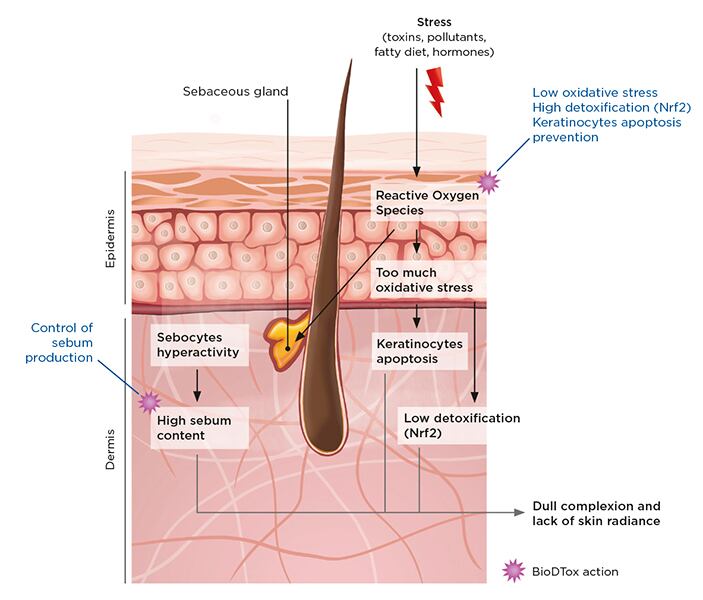
To ensure proper biological function, the skin’s circadian rhythm needs to be properly synchronized. When considering some of the constraints associated with modern lifestyles such as stress, shifts in normal working hours and exposure to blue light, typical circadian patterns or the “internal clock” is easily dysregulated and cells are “lost in time”. B-Circadin, an extract derived from Lespedeza capitata helps skin maintain or recover a normal circadian rhythm when exposed to stressful conditions such as blue light or a dysregulated lifestyle. By ensuring the proper expression of Per-2, Cry-1 and Bmal-1, B-Circadin allows biological functions such as aquaporin activity and the Nrf2 pathway to work properly. As a result, healthy skin hydration levels are restored, the detoxification process operates more efficiently and visual symptoms of skin fatigue such as under-eye puffiness and dullness are diminished.
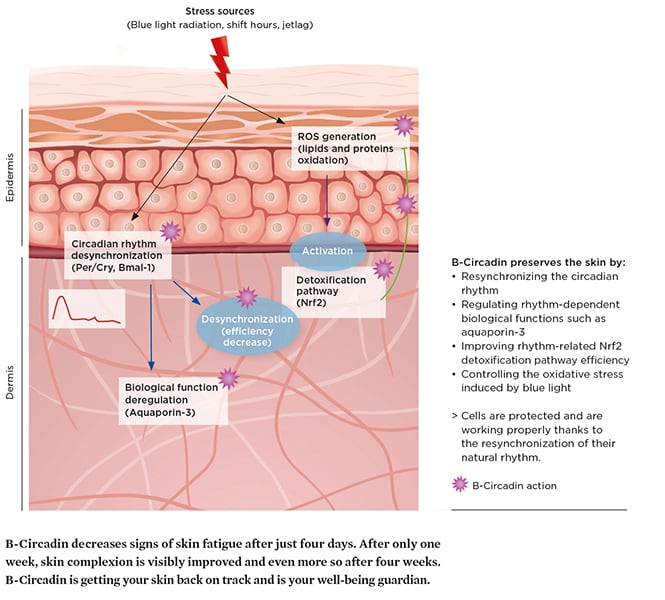
With Epseama, B-Circadin, RedSnow, Eosidin and BioDTox, formulators can develop cosmetic products for consumers searching for solutions to provide healthy aging and promote wellness. Examples of formulations combining these active ingredients can be found under the Sc[ai]turalist brand developed by Clariant Active Ingredients, for a holistic approach to well-aging.
For more information, please visit clariant.com/ActiveIngredients




